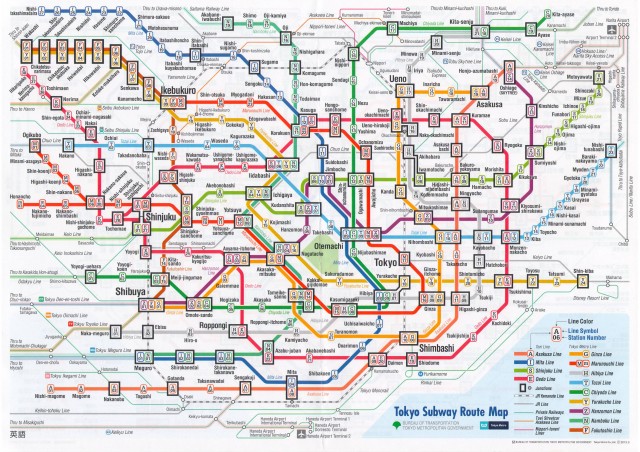
Daunting, isn’t it? 40 million passengers a day use the Tokyo transit system. Image: Tokyo Metro
This is a bit of a different post for us, about something other than just airplanes, airports & airlines. Enjoy!
It was early Thursday morning on my last day in Tokyo. It had been a whirlwind trip. Sunday and Monday had been taken up on the inaugural All Nippon Airways (ANA) flight from Vancouver (YVR) to Tokyo-Haneda (HND). I spent Tuesday at ANA’s New Employee Ceremony, and then explored HND’s observation decks. On Wednesday morning I was treated to a somewhat manic half-day bus tour of Tokyo. After that, I explored a bit, and went back to my hotel at HND’s Terminal 2 to get some work done, and to recover!
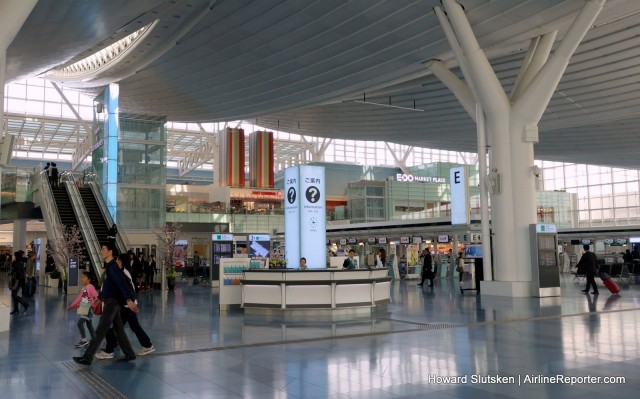
My start and end point – HND’s International Terminal
But now, I had the whole day to explore the city before returning to Haneda Airport’s International Terminal for my 9:55 pm flight. I had a long list of suggestions of things to see from friends and colleagues. Everyone had said that the best way to explore Tokyo is by transit, and I had my maps ready to go.
The statistics are phenomenal; 40 million passengers use Tokyo’s transit system, every day. Most commuters travel on Tokyo’s extensive urban railway system, and eight million use the Tokyo Metro (subway) daily. There are over 130 lines and 1,000 stations on the fully-integrated rail system. No surprise, then, that the world’s busiest train station is in Tokyo, at Shinjuku Station, with over three million passengers per day. The entire system is clean, efficient, inexpensive, and operates exactly on time, all the time.
However, there are a few things that an explorer needs to master before venturing out.
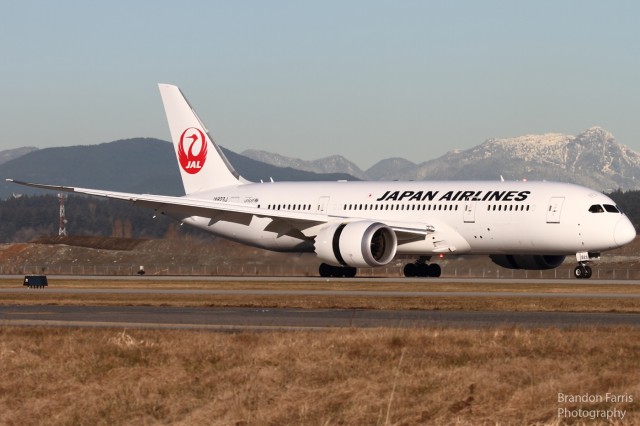
JAL 18 touches down at YVR Airport – Photo: Brandon Farris | AirlineReporter
In what turned out to be a beautiful Monday morning in Vancouver, British Columbia, reporters and the Vancouver Airport Authority greeted the airport’s first scheduled 787 service with Japan Airlines.
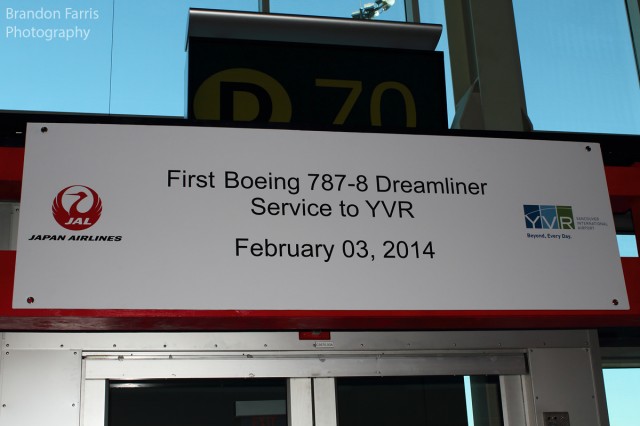
Banner welcoming passengers onboard – Photo: Brandon Farris | AirlineReporter
The conditions couldn’t have been any better for the carrier’s first arrival with the aircraft, as the skies were clear when the pilots flared the nose and gracefully put the aircraft (JA823J) on the ground 15 minutes ahead of schedule, to the delight of many who have been working hard on bringing the 787 to YVR.
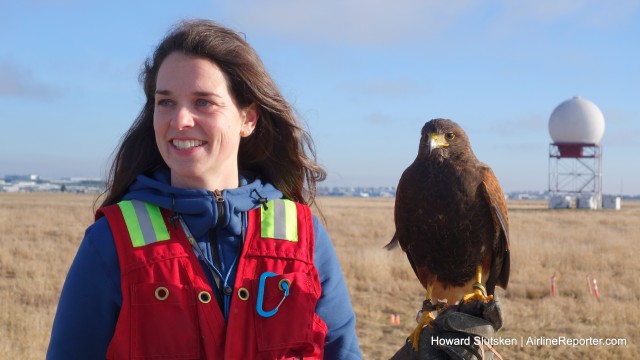
Emily Fleming, Raptor Biologist with Pacific Northwest Raptors, and Goliath, the Harris’ Hawk, in front of YVR’s radar “golf ball”
Airplanes and birds don’t play well together.
Just ask Captain Sully and First Officer Jeff, whose encounter with a flock of Canada Geese turned their A320 into a glider. Or talk to the crews of the approximately 150 planes per year at Vancouver International Airport that report bird strikes. Flight safety can be seriously compromised, repair costs for the airlines are huge, passengers are often inconvenienced, and for the birds, well, it’s fatal.
Vancouver International Airport (YVR) is located on the shores of the Strait of Georgia, on a large island in the Fraser River Delta. And just like the passengers who connect at YVR, the millions of birds that annually use the migratory Pacific Flyway like to stop in the Vancouver area to get something to eat and have a rest. Boundary Bay, south of YVR and the location of the general aviation Boundary Bay Airport (ZBB), is an internationally-recognized Important Bird Area. Even the main Vancouver air navigation aid, the YVR VOR, is on the same island as the renowned Reifel Migratory Bird Sanctuary.
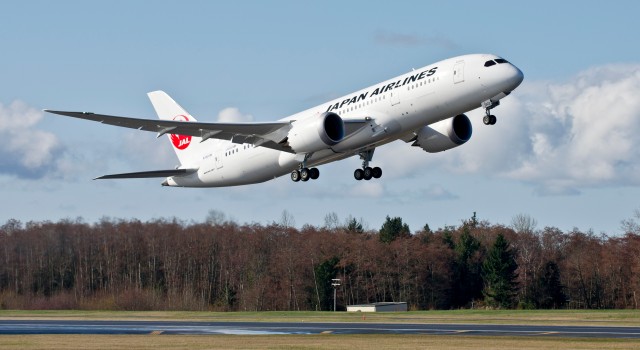
HI RES IMAGE (click for larger). JAL’s Boeing 787 Dreamliner taking off at Paine Field – Photo: Boeing
Last week, Japan Airlines announced that it will begin Boeing 787 service to Vancouver International Airport (YVR) on Monday, February 3, 2014. This will be the first scheduled arrival of a Dreamliner at YVR.
The JAL 787-8 will serve the YVR to Tokyo Narita (NRT) route, and will initially fly once per week on Mondays. Daily service will be in place by March.
We expect to see additional Dreamliner service at YVR this year, most noteably with Air Canada’s introduction of their 787-8 later in the spring. AC’s first of their 37-aircraft order, LN160, is to be registered as C-GHPQ and is currently in Position 2 of the Final Assembly Line at Boeing Everett.
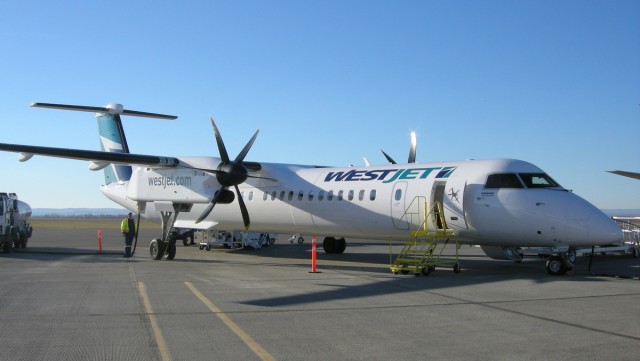
Westjet Encore Bombardier Q400 C-FENY at North Peace Regional Airport (YXJ) in Ft. St. John BC, under a beautiful blue sky. Photo: Howard Slutsken | AirlineReporter.com
This was going to be a great day for AirlineReporter.com’s Canadian “Senior Contributor.” That would be me!
I was flying with a new Canadian airline in a brand new Canadian-built plane, traveling from a major Canadian airport over some stunning Canadian landscape, and visiting the headquarters of one of “Canada’s 10 Most Admired Corporate Cultures,” which happens to be a major Canadian airline. The Flight Attendants might have made it even more Canadian by greeting me at the plane’s door with a Timmy’s “Double-Double” and a hockey stick. That didn’t happen.
Translation? I’m flying with WestJet Encore on a Bombardier Q400 from Vancouver (YVR) over the Canadian Coast Range and Rocky Mountains, and visiting Westjet’s base in Calgary (YYC). I’ll leave it to you to find out about Timmy’s.
WestJet Encore began flying in late June with two 78-seat Bombardier Q400 NextGen turboprops. Since then, five of their initial order of 20 Q400s have been delivered, and they have options on another 25 planes. WestJet Encore augments WestJet’s Boeing 737-based route structure with regional flights of distances up to 700 miles. That’s about a two hour flight time for the Q400, but most destinations are 60 to 90 minutes apart. Having the Q400 in the fleet will give WestJet the flexibility to fly to new destinations, add additional frequencies to current destinations, or “right size” the service throughout their network by swapping 737s with Q400s. The Q400s are pretty quick, with flight times within 10-20 minutes of a 737 over these short distances.
The first destinations included Nanaimo, BC in the west, and as far east as Saskatoon, SK. As more planes come into the fleet, Encore is adding destinations and continuing their expansion eastwards. Encore brought WestJet service back to Brandon, MB in September, a destination that previously couldn’t support WS 737 service. This YYC-YBR flight is currently Encore’s longest, at a bit under 2 hours. In addition to adding direct regional flights to the WestJet schedule, Encore will look to keep travellers “in the family” by providing connections to mainline WS flights, and those operated by codeshare partners. Encore is also part of the “WestJet Rewards” frequent-flier program, and shares facilities with WS at common destinations.






